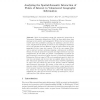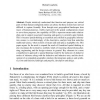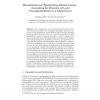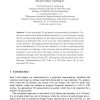COSIT
2011
Springer
12 years 11 months ago
2011
Springer
If spatial cognition hopes to understand memory of and reasoning about real-world environments, then all aspects of the environment, both spatial and non-spatial need to be conside...
COSIT
2011
Springer
12 years 11 months ago
2011
Springer
With the increasing success and commercial integration of Volunteered Geographic Information (VGI), the focus shifts away from coverage to data quality and homogeneity. Within the ...
0
posts
with
0
views
0
views
COSIT
2009
Springer
13 years 9 months ago
2009
Springer
People intuitively understand that function and purpose are critical parts of what human-configured entities are about, but these notions have proved difficult to capture formally....
GISCIENCE
2010
Springer
13 years 11 months ago
2010
Springer
Wireless sensor networks are deployed to monitor dynamic geographic phenomena, or objects, over space and time. This paper presents a new spatiotemporal data model for dynamic area...
GISCIENCE
2010
Springer
13 years 11 months ago
2010
Springer
We designed and implemented a simple and fast heuristic for placing multiple labels along edges of a planar network. As a testbed, realworld data from Google Transit is taken: our ...
GISCIENCE
2010
Springer
13 years 11 months ago
2010
Springer
The categorization of our environment into feature types is an essential prerequisite for cartography, geographic information retrieval, routing applications, spatial decision supp...
GISCIENCE
2008
Springer
14 years 15 days ago
2008
Springer
While similarity has gained in importance in research about information retrieval on the (geospatial) semantic Web, information retrieval paradigms and their integration into exist...
GISCIENCE
2008
Springer
14 years 15 days ago
2008
Springer
Abstract. Closed, watertight, 3D geometries are represented by polyhedra. Current data models define these polyhedra basically as a set of polygons, leaving the test on intersectin...
GISCIENCE
2008
Springer
14 years 15 days ago
2008
Springer
The discontinuities in boundaries and exteriors that regions with holes expose offer opportunities for inferences that are impossible for regions without holes. A systematic study ...








